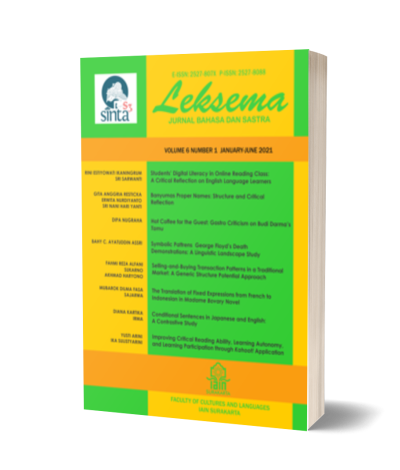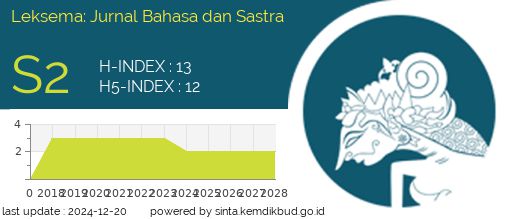CLASSIFYING VIDEO GAME TRANSLATION STUDIES FROM TRANSTEXTUALITY PERSPECTIVES
DOI:
https://doi.org/10.22515/ljbs.v4i1.1635Keywords:
transtextuality, video game translation, transversality, transcreation, transfiguration, transmediationAbstract
This paper attempts to classify video game translation(VGT)studies from the perspectives of transtextuality, Genette’s term referring to the relationships a text weaves with other texts (1992). In regard to VGT studies, applying transtextuality signifies the textuality of video game and its transtextual relationship with other texts. Transtextuality is linear to the connectionist perspectives Globalization, Internationalization, Localization, and Translation (GILT) holds, a conventional concept that houses VGT, emphasizing on the intra and inter relationships between the four elements of GILT. This necessity to consider VGT as a part of GILT is the linearity to which transtextuality conforms VGT studies. Applying transtexuality, VGT studies are classified into transversality, transcreation, transfiguration, and transmediation. Transversalityreferstothestudiesaimed at applying translation theories in VGT.Transcreation refers to VGT studies that focus on cultural issues in relation to video game mechanics. Transfiguration refers to VGT studies that incorporate game studies as a response to certain VGT issues. Transmediation refers to VGT studies that focus on the influence of video game media toward the translation aspects of video games. These four classifications construct a quadrant which opens probabilities for VGT studies to depart from the combination of each element.
Downloads
References
Aarseth, EJ. 1997. Cybertext: Perspectives on Ergodic Literature. JHU Press
Barr, P, J. Noble & R. Biddle. 2006. “Video game Values: Human–computer Interaction and Gamesâ€. Interacting with Computers, 19 (2): 180-195.
Bassnett, S. 2013. Translation Studies. New York: Routledge
Bernal-Merino, M. 2008. “Training Translators for the Video Game Industryâ€. The Didactics ofAudiovisual Translation. Ãmsterdam/Filadelfia: John Benjamins: 141-156
Bernal-Merino, MÃ. 2014. Translation and Localisation in Video Games: Making Entertainment Software Global. Routledge
Cadieux, P & B. Esselink. 2004. “GILT: Globalization, Internationalization, Localization,Translationâ€. Globalization Insider, 11 (1.5): 1-5
Calvillo-Gámez, EH, P. Cairns & AL. Cox. 2015. “Assessing the Core Elements of the Gaming Experience. In Game User Experience Evaluation: 37-62. Springer International Publishing
Chandler, HM &SOM.Deming, 2011. The Game Localization Handbook. Jones & Bartlett Publishers
Christoph, K, H. Dorothée, & V. Peter, 2009. “The Video Game Experience as ‘True’ Identification: A Theory of Enjoyable Alterations of Players' Self-perceptionâ€. Communication Theory, 19 (4): 351-373
Clearwater, D. 2011. “What Defines Video Game Genre? Thinking about Genre Study after the Great Divideâ€. Loading..., 5 (8)
Dietz, F. 2007. “How Difficult Can That Be?": The Work of Computer and Video GameLocalizationâ€. Tradumà tica: Traduccióitecnologies de la Informaciói la Comunicació, (5)
Eskelinen, M. 2012. Cybertext Poetics: The Critical Landscape of New Media Literary Theory. Bloomsbury Publishing
Fernández Costales, A. 2012. “Exploring Translation Strategies in Video Game Localisationâ€. MonTI. MonografÃas de Traducción e Interpretación, (4).
Frasca, G. 1999. “Ludology Meets Narratology: Similitude and Differences between (Video) Games and Narrativeâ€. Ludology.org
Frasca, G. 2007. Play the Message: Play, Game, and Video Game Rhetoric (Unpublished PhD dissertation) Copenhagen: IT University of Copenhagen
Genette, G. 1992. The Architext: An Introduction (31). Los Angeles: Univ of California Press
Hjorth, Larissa. 2011. Games and Gaming. New York: Oxford.
Jacobs, Dale. 2014. Design, Arthrology and
Transtextuality in Seagle’s and Kristiansen’s It’s a Bird, 5 (2): 361
Juul, J. 2001. “Games Telling Storiesâ€.Game Studies, 1 (1), 45
Juul, J & AC. Revolution. 2009. Reinventing Video Games and Their Players.
Mandiberg, S. 2015. Responsible Localization: Game Translation Between Japan and the United States. San Diego: University of California
Mangiron, C & M. O’Hagan. 2006. Game Localisation: Unleashing Imagination with ‘Restricted’ Translation. The Journal of Specialised Translation, 6: 10-21
Manovich, L. 2001. The Language of New Media. Massachussetts: MIT Press
Merino, MB. 2006. “On the Translation of Video Gamesâ€. The Journal of Specialised Translation, 6: 22-36
Merkel, M. 1996. “Checking Translations for Inconsistency: A Tool for the Editorâ€. In Proceedings of the Second Conference of the Association for Machine Translation in the Americas (AMTA-96): 157-167
Merkel, M. 1998. “Consistency and Variation in Technical Translation: A Study of Translators’ Attitudes†. Unity in Diversity: 137-149.
Molina, L. & A. Hurtado Albir. 2002. Translation Techniques Revisited: A Dynamic and Functionalist Ap-proach. Meta: Translators’ Journal, 47 (4): 498-512.
Monica, G. 2015, June 30. A Five-Minute Guide to Indonesia’s Mobile Game Market. Retrieved September 20, 2017, from <http://www.oneskyapp.com/blog/ indonesia-mobile gaming/>
Moorkens, J, S. Doherty, D. Kenny & S. O'Brien. 2014. “A Virtuous Circle: Laundering Translation Memory Data Using Statistical Machine Translationâ€. Perspectives, 22 (3): 291-303
Munday, J. 2012. Evaluation in Translation: Critical Points of Translator Decision-making. New York: Routledge
Nababan, M & A. Nuraeni, 2012. “Pengembangan Model Penilaian Kualitas Terjemahanâ€. Kajian Linguistik dan Sastra, 24 (1)
O’Hagan, M. 2005. “Multidimensional Translation: A Game Plan for Audiovisual Translationin the Age of GILTâ€. Proceedings of the Marie Curie Euroconferences MuTra‘ Challenges of Multidimensional Translation’. Saarbrücken, 2-6 May 2005: 76-87
O'Hagan, M & C. Mangiron. 2013. Game Localization: Translating for the Global Digital Entertainment Industry (106). Amsterdam: John Benjamins Publishing
O’Hagan, M & H. Chandler, 2016. “Game Localization Research and Translation Studiesâ€. Border Crossings: Translation Studies and Other Disciplines, 126: 309
Pedersen, D. 2014. “Exploring the Concept of Transcreation: Transcreation as More than Translationâ€. Cultus: The Jos Isournal of Intercultural Mediation and Communication, 7 (57):71
Purnomo, SLA. 2015. “Grab the Garb: The Influences of Translation Techniques in theLudological Aspects of Video Game Translation (A Case Study of Square Enix’sLightning Returns: Final Fantasy XIII)â€. Izumi, 4 (1): 1-9
Purnomo, SLA, M. Nababan, , R. Santosa & D. Kristina. 2016. “Game Time: Revisiting Ludic Linguistics for Video Game Analysisâ€. Prosiding Prasasti: 689-694
Purnomo, SLA, M. Nababan, R. Santosa & D. Kristina, 2016. “Ludic Translation: The Problems of Game Asset Transferability in Video Game Translationâ€. ICOLTS Proceedings: 328-335
Treanor, M, B. Schweizer, I. Bogost & M. Mateas. 2011, June. “Proceduralist Readings:How to Find Meaning in Games with Graphical Logicsâ€. In Proceedings of the 6thInternational Conference on Foundations of Digital Games: 115-122. ACM
Sajna, M. 2013. “Translation of Video Games and Films: A Comparative Analysis of Selected Technical Problemsâ€. PoznaÅ„: Polskie Towar-zystwo Badania Gier, 5: 219-232
Sicart, M. 2011. “Against Proceduralityâ€. Game Studies, 11 (3): 209
Simons, J. 2007. “Narrative, Games, and Theoryâ€. Game Studies, 7(1):1-21
Venuti, L. (1998). The Scandals of Translation: Towards an Ethics of Difference. Taylor & Francis US
Werner, JR. 2001. “Text and Context in Multimedia Translationâ€. Benjamins Translation Library, 34: 51-64.
Downloads
Published
Issue
Section
License
The copyright of the received article shall be assigned to the publisher of the journal. The intended copyright includes the right to publish the article in various forms (including reprints). The journal maintains the publishing rights to published articles.
In line with the license, the authors and users (readers or other researchers) are allowed to share and adapt the material only for non-commercial purposes. In addition, the material must be given appropriate credit, provided with a link to the license, and indicated if changes were made. If authors remix, transform or build upon the material, authors must distribute their contributions under the same license as the original.






